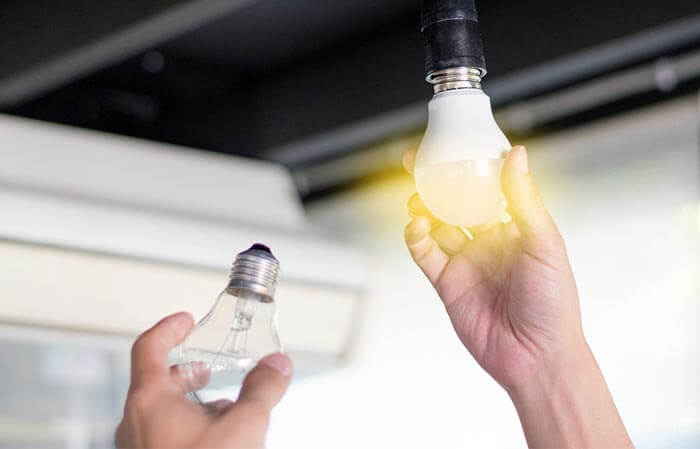All technology that you see around you has its own advantages and disadvantages, its pros and cons.

Some that are long-lasting or of good quality may be too expensive at times, some that are affordable may have a short life span.
Just like all other technology, Light Emitting Diode lighting technology, also known by the common name, LED lights have their own advantages and disadvantages as well.
Given below are 10 advantages and disadvantages of LED lights that we have gathered for you so that you can make the right decision.
Advantages of LED Lights 🙂
So here are all the reasons why you should switch to LED lights:
1. Energy-Efficient
When it comes to efficiency, LED lights offer a 70% efficiency value while other lights such as incandescent lights offer way less.
A 6 Watt LED light and a 44 Watt incandescent light produce the same amount of light.
2. Long Life-Span
LED lights, when compared to other types of lights, tend to last longer.
Their low levels of heat combined with the fact that they are energy efficient increase their life span by a good thousand hours, in comparison to the other bulbs.
3. Low Heat Levels
LED lights also produce a very low amount of heat, while incandescent lights in some cases, have even burned curtains when placed too close to them, due to the amount of heat they produce.
4. Bright Light
Another advantage of LED lights is that they are very bright and offer more light as compared to other bulbs or incandescent bulbs.
They are the most suitable ones to be used in educational institutes, offices or in study rooms, etc.
5. Environment-Friendly
It is a known fact that LED lights tend to reduce carbon emissions to a great extent.
A 60 watt light bulb, if replaced by an LED, can reduce up to 160kgs of CO2 emissions annually.
6. Reliable
Another additional advantage of using LEDs is that they do not contain any filament or any other fragile part etc. which makes them less prone to getting damaged.
They are the best fit for places like the ceiling fan fixtures with vibrations.
7. LED Night Lights
As the color of the light can be easily changed, LEDs are best to be used as night lights.
LED night light produces almost no heat and can be chosen in soothing colors that are not too sharp on the eye.
8. Reading Lamps
When it comes to its practical applications, it’s not hard to see that LED lights are the most suitable ones for reading as they are bright, intense, directional, and come with low heat levels.
The color and the brightness of the reading lamp can be adjusted to taste as well.
9. Directional Light
LED lights to provide lighting in one direction only, rather than spreading it in all directions and due to their directional nature of the light not only offer brighter, more intense light but are also more suitable for purposes such as downside lighting.
10. Wide Range of Light Colors
Incandescent lights change color with the help of filters; LED lights, on the other hand, offer colors by a coating on their diode, which is long-lasting and offers colors and many shades of that color.
Disadvantages of LED Lights 🙁
Here are some of the disadvantages of LED lights:
1. Costly
Even though they save money in the long run, initially, they cost higher than any other lights, which can be unaffordable at times.
2. Effect on Insects
Insects are generally attracted to LED more as compared to the other ones.
This is slightly disturbing and has environmental hazards as well.
3. Use in Winters
As the LED has low levels of heat, therefore, in winters, snow may freeze on their surface, which in case of a traffic light may result in an accident, as the snow will cover up the light, and it will be hard for the driver to see.
4. Drop-in Efficiency
With the passage of time and especially, if the high current passes through the LED that is higher than the threshold of the required current, then the efficiency of the LED drops.
5. Dependent on the Temperature of the Surrounding
Due to their dependence on temperature, LED lights may fail to function if the temperature exceeds a certain threshold.
A heat sink in such a case is required.
6. Sensitive to Voltage Change
Change in voltage leads to a change in current, which in turn can decrease the lifespan of the bulb by folds.
7. Blue Hazard
LED lights are known to have crossed the safety limit of the blue hazard, which may cause harm to your eyes.
8. Cause Light Pollution
These lights tend to release more blue light, as compared to the other types of lights, which cause light pollution.
9. No Spherical Light Field
As LED lights are directional in nature; therefore, they cannot be sued for spherical light fields or at places where light is required in all directions.
10. Quality of the Light
LED lights have a different spectrum than incandescent ones. Due to this, we see colors slightly different as compared to under other light sources.
Conclusion
LED lights generally have more pros than cons; therefore, they are used in masses around the world for various applications.
Therefore, understand the reasons why you want LED lights and choose accordingly.





